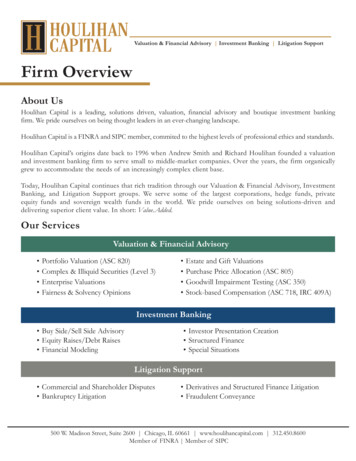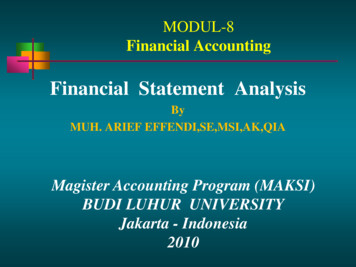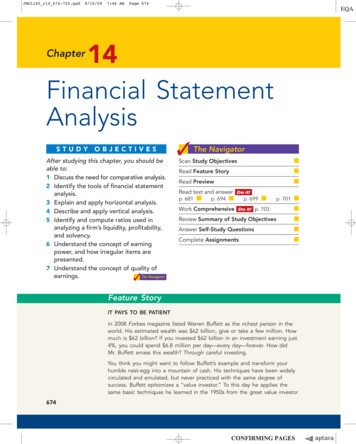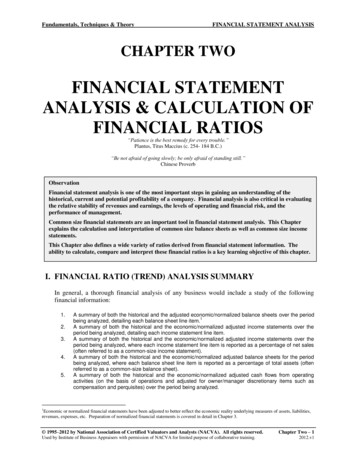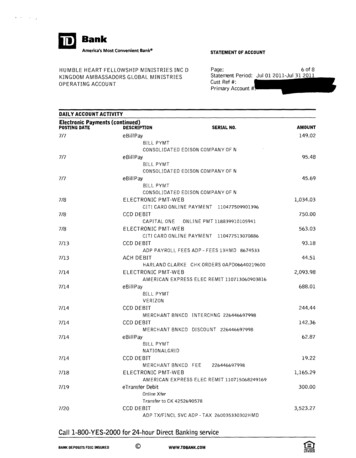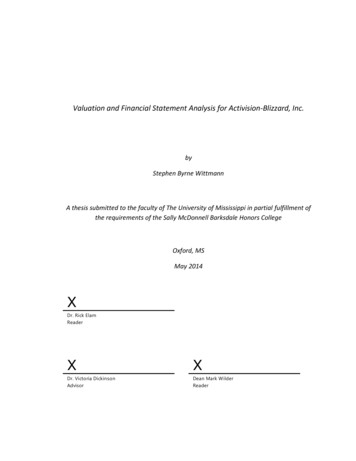
Transcription
Valuation and Financial Statement Analysis for Activision-Blizzard, Inc.byStephen Byrne WittmannA thesis submitted to the faculty of The University of Mississippi in partial fulfillment ofthe requirements of the Sally McDonnell Barksdale Honors CollegeOxford, MSMay 2014XDr. Rick ElamReaderXXDr. Victoria DickinsonAdvisorDean Mark WilderReader
2014Stephen Byrne WittmannALL RIGHTS RESERVEDii
ABSTRACTSTEPHEN BYRNE WITTMANN: Valuation and Financial Statement Analysis for ActivisionBlizzard, Inc.(Under the direction of Dr. Victoria Dickinson)Activision-Blizzard (ATVI), a market-leading publisher and developer in the videogameindustry, represents a fascinating case study of a player in a relatively new industry as itstruggles to find a permanent place among entrenched entertainment staples such as music,television, and movies. The company in its present form is the product of a 2008 mergerbetween Activision Inc. and Vivendi Games, thus creating a massive publisher with rights toseveral of the industry’s most popular franchises, including World of Warcraft, StarCraft, andCall of Duty. This industry domination has not gone unnoticed, and as of March 2013, ATVI’sshare price has seen a 41 percent leap following strong earnings releases this year. Furthermore,Vivendi Universal, the French parent company, has shown an interest in selling ATVI as theconglomerate moves to divest several of its subsidiaries.This paper determined that ATVI was a suitable and attractive candidate for anacquisition due to its large cash pile ( 4 billion) and valuable intellectual property. In July, 2013the company was the target of a buyout led by several prominent executives and investors withthe objective of moving the dynamic, growing organization away from the stagnating Frenchconglomerate, Vivendi. This action lent credence to the early opinions reached in this paperfollowing a detailed financial statement and valuation analysis, and should be the beginning ofan exciting new chapter for ATVI and its stakeholders.iii
Table of ContentsList of Tables and Figures . viList of Abbreviations . viiIntroduction . ixCh.1 . 1Section 1.1: Core Business Operations . 1Section 1.2: Supply and Demand Considerations . 2Section 1.3: Competitive Analysis . 5Section 1.4: Corporate Website Disclosure . 9Section 1.5: Asset Composition . 11Section 1.6 Financing and Liability Composition . 14Section 1.7: Valuation Considerations . 17Section 1.8: Cash Flow Analysis . 18Section 1.9: Basic Financial Statement Ratio Analysis . 24Section 1.10: Disclosure Considerations. 27Section 1.11: Board of Directors Analysis . 29Ch.2 . 33Section 2.1: Ratio Analysis . 33Section 2.2: RNOA Disaggregation. 39Section 2.3: NOR Disaggregation . 41Section 2.4: Liquidity and Solvency Ratios . 42Section 2.5: Vertical and Horizontal Analysis . 45Section 2.6: Selected Operating Margins . 47Section 2.7: Ratio Limitations . 50Section 2.8: Revenue Recognition Policies . 51Section 2.9: Restructuring Charges . 52Section 2.10: Foreign Currency Adjustments . 53Section 2.11: Earnings Per Share . 54Ch.3 . 56Section 3.1: Receivable Analysis . 56Section 3.2: Inventory Analysis . 61iv
Section 3.3: Property, Plant, and Equipment Analysis. 65Section 3.4: Intercorporate Investments and Goodwill . 68Section 3.5: Share Repurchases, Stock Dividends, and Stock Splits . 69Section 3.6: Operating Leases . 71Section 3.7: Pension Considerations . 74Ch.4 . 75Section 4.1: Financial Statement Projections . 75Section 4.1.1: Income Statement Projections . 75Section 4.1.2: Balance Sheet Projections . 77Section 4.1.3: Cash Flow Statement Projections . 77Section 4.2: WACC Calculation. 78Section 4.2.1: Cost of Equity . 78Section 4.2.2: Cost of Debt . 79Section 4.2.3: WACC Value. 80Section 4.3: Public Comparables Analysis . 80Section 4.4: Discounted Cash Flow Analysis. 82Section 4.5: Residual Operating Income Model . 84Ch. 5: Conclusions . 86Bibliography . 89v
List of Tables and FiguresTable 1Operating Vs. Non-Operating Activities: Income Statement . 20Table 2Operating Vs. Non-Operating Items: Balance Sheet .21Table 3Return on Assets . .25Table 4Return on Equity . .26Table 5State and Federal Tax Rates . .33Table 6Net Operating Profit After Taxes . . .35Table 7Net Operating Assets . .36Table 8Return on Net Operating Assets . .37Table 9Return on Equity . .38Table 10Non-Operating Return , .39Table 11Net-Operating Profit Margin . 40Table 12NOAT .41Table 13Current Ratio 43Table 14Quick Ratio 44Table 15Liabilities to Equity .45Table 16Gross Profit Margin 48Table 17SG&A/Sales .48Table 18R&D/Sales 50Table 19Earnings Per Share .55Table 20Accounts Receivable Turnover .57Table 21Average Collection Period 58Table 22Inventory Turnover .63Table 23Average Inventory Days Outstanding . .63Table 24Valuation Model Price Comparisons .85vi
List of AbbreviationsACPAverage Collection PeriodAIDOAverage Inventory Days OutstandingAPICAdditional Paid-In CapitalARTAccounts Receivable TurnoverATVIActivision-BlizzardCapexCapital ExpendituresCAPMCapital Asset Pricing ModelCOGSCost of Goods SoldDCFDiscounted Cash FlowEAElectronic ArtsEBITDAEarnings Before Interest, Taxes, and DepreciationEBITEarnings Before Interest and TaxesEPSEarnings per ShareEVEnterprise ValueFIFOFirst-In-First-OutFLEVFinancial LeverageGAAPGenerally Accepted Accounting PrinciplesGPMGross Profit MarginIPIntellectual PropertyITInventory TurnoverLIBORLondon Interbank Offer RateLIFOLast-In-First-OutMMORPGMassively Multiplayer Online Role Playing Gamevii
NOANet Operating AssetsNOATNet Operating Asset TurnoverNOPATNet Operating Profit After TaxesNOPMNet Operating Profit MarginNORNon-Operating ReturnPCPersonal ComputerPPEProperty, Plant, and EquipmentR&DResearch and DevelopmentRNOAReturn on Net Operating AssetsROAReturn on AssetsROEReturn on EquityROPIResidual Operating IncomeSECSecurities and Exchange CommissionSG&ASelling, General and AdministrativeTTMTrailing-Twelve MonthsWACCWeighted Average Cost of Capitalviii
IntroductionActivision-Blizzard (ATVI) is a market-leading publisher and developer in the videogameindustry. The company holds rights to many of the most-recognizable videogame franchises inthe world, including World of Warcraft, and Call of Duty. This dominant position gives thecompany great influence in the industry, but also makes it and its franchises a target for upstartdevelopers on home consoles, PCs, and, increasingly, mobile platforms. In an industry wherecompanies live and die by the renewed popularity of their titles, ATVI cannot afford to becomecomplacent, and must continue innovating and adopting risky new ventures in order torejuvenate and expand its offerings.In this paper I aim to present a detailed fundamental and technical analysis of ATVI,drawing upon information presented in recent investor filings and equity research. Followingthis, I will perform a valuation of the company utilizing several key methodologies, includingtrading comparables, precedent transaction analysis, and discounted cash flow. Finally, I willoffer insight into the company’s future prospects and the possibility of it being the target of abuyout. This will provide a first-hand look into the biggest player in an industry that, despite itsrelatively brief existence, has done more to mold the entertainment culture of the world todaythan almost any other medium, and whose future is more uncertain than ever.ix
Ch.1Section 1.1: Core Business OperationsIn order to analyze ATVI from the ground up, it is important to define exactly whatsectors it operates in, as well as its core business structure. ATVI’s operations focus primarily onpublishing online, personal computer (PC), console, handheld, and mobile games. Thecompany’s current organizational structure operates in three segments. These include 1)Activision Publishing, Inc., 2) Blizzard Entertainment, Inc., and 3) Activision Blizzard distribution.Section 1.1.1: Activision PublishingActivision Publishing, Inc. is a leading international publisher of interactive media,focusing on developing and publishing video games based on popular franchises and licenseagreements. These operations involve the development, marketing, and sales of products whichare sold through both retail channels, as well as digital downloads. Activision develops for allmajor video game consoles, including the Sony Computer Entertainment, Inc. PlayStation 3,Nintendo Co. Ltd. Wii, and Microsoft Corporation Xbox 360. Activision also owns several popularintellectual properties, including the Call of Duty franchise. The publisher is currently asubsidiary of Activision Blizzard.1
Section 1.1.2: Blizzard Entertainment, Inc.Blizzard Entertainment, Inc. is a leader in subscription-based massively multiplayeronline role-playing games, including the leader in terms of revenue and subscriber base, Worldof Warcraft. Blizzard internally develops and publishes PC games, as well as its online gamingcommunity and service, Battle.net. Blizzard’s primary forms of revenue include subscriptions(including game time for World of Warcraft), physical boxed products, digital distribution of PCproducts, and licensing of products to third-party distributors. Blizzard owns the rights to severalpopular PC franchises, including World of Warcraft, Starcraft, and Diablo. It should be noted thatBlizzard, Inc. was originally owned by Vivendi SA and remains a separate entity with individualmanagement.1 Vivendi SA, is headquartered in Paris and owns a 52 percent stake in thecompany.Section 1.1.3: Activision Blizzard DistributionActivision Blizzard Distribution includes warehousing, logistical, and sales distributionservices through operations in Europe. These services are provided to third-party publishers ofinteractive entertainment software, as well as internal publishing operations and interactiveentertainment hardware. Overall, Activision Blizzard’s core operations consist of severalpowerful publishing and developing operations which continue to lead the interactiveentertainment software industry in terms of profitable intellectual properties (IPs) and revenuecreation.1Activision-Vivendi Merger: 5 Key Points, Simon Carless2
Section 1.1.4: LocationsActivision Blizzard’s corporate headquarters is located in Santa Monica, California whileBlizzard’s development studio is based in Irvine, California. The corporation maintainsoperations in the U.S., Canada, the United Kingdom, France, Germany, Ireland, Italy, Sweden,Spain, Norway, Denmark, the Netherlands, Australia, India, China, South Korea and the region ofTaiwan. Sales offices are located domestically in Texas, Minnesota, and Arkansas, and studiosare in Texas, California, Iowa, New York, and Wisconsin. Domestic manufacturing anddistribution centers are maintained only in California.2Activision Blizzard has a strong international and domestic presence, with major studiosand offices located in almost every major country of the world (ATVI 10-K). Internationally,Activision Blizzard’s corporate offices are based in the Netherlands, the United Kingdom, andFrance. International sales offices are spread across the Netherlands, Switzerland, Argentina,Denmark, Italy, Spain, Mexico, Canada, Germany, Norway, France, Brazil, China, Australia,Taiwan, and Singapore. Studios are located in Ireland, The United Kingdom, Canada, South Korea,and China. Finally, international manufacturing and distribution centers operate in the UnitedKingdom, Germany, China, and the Netherlands.Section 1.2: Supply and Demand ConsiderationsThe videogame market is a demand-driven industry where a company is only as valuableas its most successful franchise. Next, I discuss ATVI’s recent sales patterns and the strength ofthe company’s development talent.2ATVI Inc.-2011 Annual Report. Retrieved 6/9/2012, from fo.aspx?FilingID 8444785-12514-55963&type sect&dcn 0001047469-120017752
Activision Blizzard enjoys a strong demand for many of its most revered franchises. Thisis due primarily to a consistently high-production quality and a legion of long-standing, loyal fans.These games span many genres, from the massively multiplayer online role-playing game (orMMORPG), World of Warcraft, to the popular first-person shooter game, Call of Duty. World ofWarcraft, which is operated on a subscription basis, remains the most popular MMORPG in theworld, boasting a peak subscriber base of 12 million in October 2010.3 Meanwhile, the Call ofDuty series has shattered sales records with each subsequent release. The most recent entry,Call of Duty: Modern Warfare 3 became the fastest selling game of all time, moving 6.5 millioncopies on launch day in the U.S. and U.K. alone. More recently, the release of Blizzard’s longawaited Diablo 3 topped sales of more than 3.5 million copies within 24 hours of its launch onMay 15, 2012.ATVI’s valuable franchises and intellectual properties garner it strong demand upon therelease of each addition to these series, however many of the company’s other products havefallen upon hard times as of late, and failed to gather enough sales to remain viable. Severalstudios owned by ATVI, including RedOctane, publisher of the once-popular Guitar Herofranchise, closed their doors in 2011. This was explained in ATVI’s 2011 10-k as a “restructuringplan involving a focus on the development and publication of a reduced slate of titles on agoing-forward basis, including the discontinuation of the development of music-based games,the closure of the related business unit and the cancellation of other titles then in production”.4These sweeping cuts were made to many company-owned studios, as demand for music andrhythm franchises began to run out of steam and effort was focused on trimming down I Inc.-2011 Annual Report. Retrieved 6/9/2012, from fo.aspx?FilingID 8444785-12514-55963&type sect&dcn 0001047469-1200177543
supporting other core products and proven intellectual properties.5 Although demand hasfluctuated stronger than usual in recent years, ATVI remains an industry leader in unit sales andoverall revenue, mostly due to their steadfast core franchises.As a publisher and developer, much of ATVI’s supply inputs are labor-oriented. Thecompany must maintain a staff in their international studios, as well as sales offices anddistribution centers. As of December 31, 2011, ATVI consisted of 7,300 full-time and part-timeemployees. It should also be noted that 117 of the full-time employees were subject to termemployment agreements, most of which were executive officers and select members from thesales, marketing, and product development. In addition, many employees in France, Spain, Italy,and distribution companies in Germany are subject to coll
Valuation and Financial Statement Analysis for Activision-Blizzard, Inc. by Stephen Byrne Wittmann A thesis submitted to the faculty o

